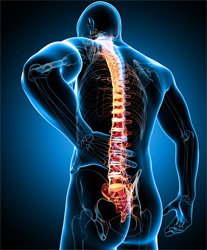
More specifically, the term Sciatica refers to inflammation or irritation of the sciatic nerve. This can happen as the result of a number of other conditions like a degenerative disc, herniated disc, spinal stenosis or other conditions which place pressure on the sciatic nerve.
The sciatic nerve is considered the single longest nerve throughout the body, and when irritated you can feel symptoms wherever the nerve goes.
Most people feel pain, tingling, or numbness down the back of their leg mainly in the area of the hamstrings. The hamstrings extends from the buttock to the knee, however these sensations can go down to the calf and at times even to the foot. It is typically felt in one leg, but in more severe cases can be felt in both legs.
Sciatica can also vary in intensity. Often times, it is a sharp pain that limits your ability to sit, walk or drive. In other instances, it is described as a constant ache that gets worse with certain activities.
What Causes Sciatica?
There can be several causes for sciatica, but they all have one thing in common. Each issue places excessive pressure, compression or irritation on the sciatic nerve.
The most common causes for sciatica are:
- Muscle spasm in the low back where then nerve exits the spine
- Disc Bulge
- Disc Herniation
- Stenosis (or narrowing) of the holes that the nerves go through
- Degenerative joint disease of the lower lumbar spine
- Degenerative disc disease of the lower lumbar spine
- Muscle tightness around the sciatic nerve
- Hamstrings
- Piriformis
- Gluteal muscles
- Stretch injury to the nerve
- Compression injuries to the disc or vertebrae
Related Links
- How to Get Rid Of Sciatica Naturally?
- What Does a Herniated Disc Feel Like?
Leave A Comment